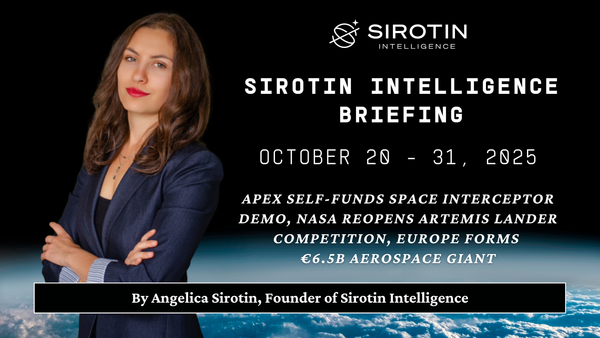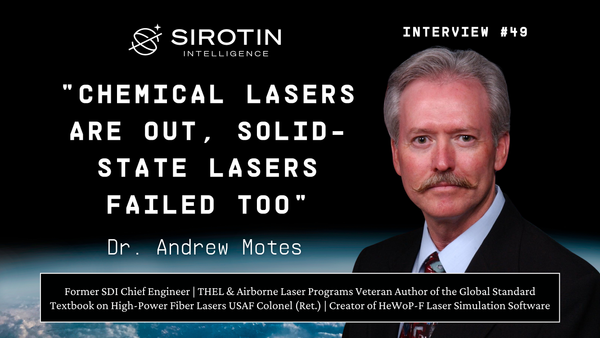Sirotin Intelligence Briefing: May 26-31, 2025: Russia China & North Korea Criticize Golden Dome as Starship Suffers Another RUD, China Arms Tiangong with Defense Bots, Space Command Faces Infrastructure Crisis
Russia China & North Korea Criticize Golden Dome as Starship Suffers Another RUD, China Arms Tiangong with Defense Bots, Space Command Faces Infrastructure Crisis

This week's space intelligence highlights: Russia, North Korea and China condemn Trump's Golden Dome project as a violation of space militarization agreements while legal experts question compliance with the 1967 Outer Space Treaty, as SpaceX's ninth Starship test flight ends in another "rapid unscheduled disassembly" despite showing improvement in flight control systems. China announces plans to arm its Tiangong space station with autonomous defense robots amid growing orbital security concerns, while the GAO finds Space Command's Colorado headquarters unsustainable without major new construction investment. Commercial developments accelerate as Space One and Space BD prepare military satellite launches for Japan, Russia unveils a $5.6 billion space program targeting critical capability gaps, and Chinese company Space Epoch conducts key reusable rocket tests. Meanwhile, scientific breakthroughs emerge with new universe expansion measurements potentially resolving the Hubble tension, possible dwarf planet discoveries complicating Planet 9 theories, and Earth observation satellites revealing volcanic systems on secret Soviet installations. As aerospace medicine programs launch to study long-term space travel effects and major organizations collaborate to expand the ASCEND 2026 conference, the space sector continues its rapid evolution amid growing geopolitical tensions and technological competition.
🛡️ Defense Highlights
- China Plans Self-Defense Bots for Tiangong Space Station: Beijing is developing autonomous defense robots to protect its space station from debris and potential threats, according to Chinese scientists. The announcement signals China's growing concern about space security as orbital traffic increases and geopolitical tensions extend into space.
- Karman Space Defense Acquires Industrial Solid Propulsion: The acquisition strengthens Karman's portfolio in energetic propulsion technologies for next-generation UAS, intercept systems, and rocket-assisted takeoff platforms. The deal positions the company to capitalize on growing defense demand for advanced propulsion solutions.
- New Report Details China's Push to Dominate Artificial Intelligence: A comprehensive analysis reveals Beijing's systematic strategy to achieve AI supremacy through massive investments, strategic partnerships, and coordinated government-industry collaboration. The report highlights concerns about China's rapid progress in military AI applications and dual-use technologies that could reshape global power dynamics.
- Russia Attacks Trump's Golden Dome Project: Moscow condemned the U.S. missile defense initiative as a violation of space militarization agreements and a threat to global strategic stability. Russian officials argue the orbital interceptor system undermines existing arms control frameworks and could trigger a new space arms race.
- Trump's Golden Dome Faces 1967 Outer Space Treaty Challenges: Legal experts question whether the space-based missile defense system violates international space law prohibiting military installations in orbit. The project's compliance with the Outer Space Treaty remains contentious as nations debate the boundaries between defensive and offensive space capabilities.
- Space One and Space BD to Launch Satellite for Japanese Military: The partnership will deploy defense-related satellites as Japan expands its space-based military capabilities amid regional security concerns. The collaboration reflects Japan's growing investment in space defense infrastructure and intelligence gathering capabilities.
- Space Command Headquarters in Colorado Not Sustainable Without New Construction: A Government Accountability Office report found that the current Colorado Springs facility cannot adequately support Space Command's expanding mission without significant infrastructure investments. The findings add urgency to ongoing debates about the command's permanent location and resource requirements.
🌐 Policy, Geopolitical & Legal Developments
- University of Colorado Boulder Announces New Space Policy Center: The university is establishing a dedicated research center focused on space governance, policy analysis, and regulatory frameworks as commercial space activities rapidly expand. The center aims to address critical gaps in space law and international cooperation mechanisms.
- Russia Sets $5.6B Space Program Seeking to Close Gaps in Space Race: Moscow unveiled an ambitious multi-year space budget aimed at revitalizing its space capabilities and competing with American and Chinese advances. The funding targets critical areas where Russia has fallen behind, including commercial launch services and next-generation satellite technologies.
- AIAA, CSF, SFA and SGAC Collaborate to Expand ASCEND 2026: Major aerospace organizations are joining forces to expand the premier space conference in Washington D.C., reflecting the industry's rapid growth and need for enhanced collaboration. The expanded event will address emerging challenges in space policy, technology, and international cooperation.
- Pioneering Aerospace Medicine Program to Study Long-Term Effects of Space Travel: Researchers are launching a comprehensive study to understand how extended space missions affect human health, addressing critical knowledge gaps for future Mars missions. The program will examine physiological and psychological impacts that could shape crew selection and mission planning for deep space exploration.
🛰️ Technology & Commercial Developments
- SpaceX Conducts Ninth Starship Test Flight: The latest test flight demonstrated continued progress in SpaceX's development of the world's most powerful rocket system, designed for Mars missions and lunar operations. The flight tested new flight profiles and systems ahead of operational deployment.
- China's Mission to Grab Near-Earth Asteroid Samples: Beijing's latest space mission will attempt to collect samples from a near-Earth asteroid, advancing China's deep space exploration capabilities. The mission represents a significant step in China's growing asteroid research program and potential resource extraction ambitions.
- Scientists Find Possible New Dwarf Planet: Researchers discovered what could be a new dwarf planet in the outer solar system, though the finding may complicate the search for the hypothetical Planet 9. The discovery adds to our understanding of the solar system's outer regions while raising new questions about planetary formation.
- New Measurement Suggests Resolution to Universe Expansion Conflict: University of Chicago researchers developed a new method for measuring cosmic expansion that could resolve the "Hubble tension" - the discrepancy between different measurements of how fast the universe is expanding. The breakthrough may fundamentally change our understanding of cosmic evolution and dark energy.
- Musk Still Hoping for First Starship to Mars Next Year: SpaceX CEO maintains ambitious timeline for inaugural Mars mission despite ongoing technical challenges and regulatory hurdles. The accelerated schedule reflects Musk's determination to establish interplanetary transportation capabilities ahead of optimal launch windows.
- IFT-9 Another RUD for Starship But Shows Improvement: SpaceX's ninth integrated flight test ended in another "rapid unscheduled disassembly" but demonstrated significant progress in flight control and systems performance. The test provided valuable data for upcoming flights while highlighting the iterative development approach toward operational capability.
- China's Space Epoch Conducts Key Test for Reusable Rocket Ambitions: The Chinese company successfully completed critical testing for its reusable launch vehicle, marking another milestone in China's effort to compete with SpaceX's proven landing technology. The test advances China's commercial space sector and reduces dependence on expendable launch systems.
- Quadruple Volcanoes on Secret Soviet Military Base Linked to Climate-Altering Eruption: Earth observation satellites revealed four volcanic systems on a formerly classified Soviet installation that may have contributed to a massive climate-disrupting eruption 200 years ago. The discovery demonstrates how space-based monitoring can uncover previously unknown geological hazards and their historical climate impacts.
💭 A Word From Christophe Bosquillon
The EU Space Days 2025 - Business & Defence took place on 27-28 May in Gdańsk, a thriving hub for space, also home to POLSA Polska Agencja Kosmiczna (Polish Space Agency). This European Commission event for space policy, business and innovation, coincided with the final days of the Polish Presidency of the Council of the EU, rotating every 6 months among 27 Members States.
During the first day's first session, 'European Space Policy - Where do we Stand & What are the Challenges Ahead?', we witnessed "Europe" coming around its geopolitical identity, strategic culture, and defense posture, to unify its capacity building. During the second session 'Competitiveness of the EU Space Industry', panelists addressed thorny issues yet to be solved: the European industrial base must better compete with dominant space powers. Mechanisms to foster innovation are required. Governments must act as better anchor customers, while unifying fragmented markets and supply-chains. European culture must adopt risk-taking and failing-forward. These discussions come at a time when strong skepticism lingers about the viability of IRIS2 ('IRIS square'), aka Infrastructure for Resilience, Interconnectivity and Security by Satellite, a constellation of several hundreds satellites in medium and low Earth orbits planned for the 2030s, to provide secure connectivity and broadband services.
Meanwhile, back at the ranch, discussions and explanations for the design and deployment of America's 'Golden Dome' are in full swing, and SpaceX have launched yet another GPS III satellite for the US military. And on the opposite side of the Pacific Rim, the PRC has just launched yet another Shijan-26 spy satellite on top of a Long March 4B rocket. The PRC also just funded Astronstone, yet another Starship clone, chopsticks included.
The PRC keeps forging ahead for AI ultra-dominance in tech leadership and military modernization, in space as on Earth. “China’s AI Infrastructure Surge”, a new report released May 29 by the Special Competitive Studies Project and the intelligence firm Strider Technologies, describes how the Chinese government coordinates a 250 AI-focused data centers expansion across national ministries and provincial authorities, to train and run large-scale models toward global AI and space dominance.
Have a great space week ahead!
🎤 Our Next Guest: Joe Weiss
Thursday, June 5th – Joe Weiss on Why Ground Stations Are the Achilles' Heel of Modern Space Operations
Joe Weiss, the "Father of Industrial Control Systems Cybersecurity" and author of over 100 papers on control system security, joins us to discuss the critical vulnerabilities in terrestrial infrastructure supporting space operations and why the engineering-cybersecurity divide creates dangerous blind spots in our orbital defense.
🔍 Topics Covered:
- How the disconnect between engineering and cybersecurity creates two separate universes with minimal overlap
- Why ground stations rely on decades-old industrial technologies developed in the 1970s-1990s when security wasn't even considered
- The alarming reality that everything designed for reliability, safety, and efficiency also makes systems cyber-vulnerable
- How 17 million documented control system cyber incidents (claiming over 30,000 lives) remain largely unrecognized as cybersecurity events
- Why the 2022 Russian cyberattack against Viasat represents just the beginning of space infrastructure targeting
- The critical lessons from Estonia's cyber attacks and the first NATO cybersecurity conference
- How autonomous space systems have always existed but lack the security frameworks for modern threats
- Why adversaries like Russia, China, and Iran are exploiting the gaps between OT networks and control system field devices
- The fundamental policy changes needed to protect commercial space sector from similar threats
Don't miss this eye-opening conversation with the industry expert who has spent four decades documenting the vulnerabilities that could cripple our space infrastructure—not from orbit, but from the ground beneath our feet.
📚 Essential Intel from Our Archives
Missed a beat? These groundbreaking conversations are must-reads:
"I Created a Language That Lets AI Think in 128 Dimensions"
Former corporate sales executive Chris McGinty reveals how his McGinty Equation unifies quantum mechanics with relativity through fractal geometry, creating Hyperfluid AI and revolutionary space-folding technologies now being adopted by NATO defense strategists.
"I'm on a Crusade to Expand the Domain of Life"
Space pioneer Rick Tumlinson reveals how he created the NewSpace movement, his work with Dr. Gerard K. O'Neill, and his 40-year mission to expand humanity beyond Earth through commercial space ventures.
"Space Law Is The First Domain Where Nations Agreed On Rules Before Having Practice"
Military JAG-turned-attorney Trevor Hehn explains how Cold War-era space treaties meet modern commercial ventures, highlighting the challenges of resource utilization, dual-use technologies, and regulatory navigation for companies expanding beyond Earth's atmosphere.
"The Unprotected Power Grid Will Be Our Civilization's Death Warrant If We Don't Act"
Doug Ellsworth, Co-Director of the Secure the Grid Coalition, warns about America's vulnerability to electromagnetic pulse attacks and advocates for urgent power grid protection to prevent catastrophic infrastructure collapse.
"When AI Designs Components, They Sometimes Defy Textbook Engineering"
Space Force Lt. Colonel Thomas Nix reveals how 3D printing and AI are creating revolutionary spacecraft designs, with parts that are stronger and lighter than what human engineers could develop using traditional methods.
"The Gaps in Our Lunar Knowledge Are Enormous"
Extraterrestrial Mining Company Chief Scientist Dr. Ruby Patterson describes the urgent need for more lunar geological data before making commercial decisions, while offering a balanced view on helium-3 mining and advocating for inclusive international cooperation in cislunar space.
"We're Building the Railroads of the Space Gold Rush"
Space Phoenix Systems CEO Andrew Parlock positions his company as "FedEx for space," creating an infrastructure that helps businesses launch and return payloads from orbit with minimal friction.
"Our Nuclear Shield Was Killed For Political, Not Technological Reasons"
Reagan's SDI Director Ambassador Henry Cooper argues that effective missile defense technology developed during the Reagan-Bush years was abandoned for political reasons when the Clinton administration "took the stars out of Star Wars."
"Every Country Has a Border with Space"
UK Space Agency CEO Dr. Paul Bate is developing Britain's space industry through initiatives like spaceports in Scotland's Shetland Islands to establish the UK as Europe's premier satellite launch destination.
"We're Treating Satellites Like They're Still In The 1990s"
Niha Agarwalla, Director of Commercial Space, explains why traditional satellites are obsolete and how resilient constellations will transform space economics.
"When People See Space Guardians in Uniform, They Ask If They're Real"
Colonel Bill Woolf, 25-year space defense veteran, reveals his mission to build public support for the newest military branch defending America's orbital assets.
"One Kilogram of Helium-3 Is Worth $50 Million"
Jeffrey Max, Magna Petra CEO, explains how lunar resource extraction could revolutionize Earth's energy production and fuel humanity's expansion across the solar system.
"I'm Building a Rocket Engine That Could Reach Alpha Centauri"
Michael Paluszek, Princeton Satellite Systems President, reveals how fusion propulsion could reduce travel times throughout our solar system and enable humanity's first interstellar missions.
Chris Newlands, CEO of Space Aye, discusses how his company's satellite technology is revolutionizing wildlife conservation and helping to combat illegal fishing and poaching.
"I Learned From the Last Generation of Manhattan Project Veterans”
Patrick McClure, former Kilopower Project Lead at Los Alamos National Laboratory, explains how small nuclear reactors could power future missions to the Moon, Mars, and beyond.
"We're Being Attacked Every Day"
Christopher Stone, Former Pentagon Space Advisor, warns about America's vulnerabilities in orbit and explains why China's "attack to deter" doctrine makes space conflict more likely than many realize.
"I Helped SpaceX Secure Their First Commercial Contracts"
Serial entrepreneur Robert Feierbach discusses building billion-dollar space ventures across four continents and developing North America's newest spaceport.
"We Can Fly 8,000 Miles In 2 Hours"
Jess Sponable, Ex-DARPA PM & President of NFA, explains how rocket-powered aircraft will revolutionize global travel through simplified hypersonic technology.
"This Could Be Our Biggest Economy"
Kevin O'Connell, Former Space Commerce Director, reveals how space is transforming from a government domain to a $1.8 trillion market.
"How Do You Win a War in Space?"
Ram Riojas, Ex-Nuclear Commander and Space Defense Expert, explains why the next war will start in space and how nations are preparing their defenses.
"First Day on the Job, Hubble Was Broken"
Mike Kaplan, James Webb Space Telescope Pioneer, reveals how early setbacks with Hubble shaped NASA's approach to complex space missions and discusses the commercial revolution transforming space exploration.
The Future of Human Space Habitation
Jules Ross reveals how her journey from artist to space visionary is reshaping human adaptation to space through Earth's first artificial gravity station.
Attorney Michael J. Listner unpacks the complex legal challenges facing modern space activities. From resource rights to orbital debris management
Making Oceans Transparent From Space
Navy Legend Guy Thomas, inventor of S-AIS, shares how his invention transformed global maritime surveillance and security.
Sources
https://spacenews.com/university-of-colorado-boulder-to-announce-new-space-policy-center/
https://news.uchicago.edu/story/new-measure-universes-expansion-suggests-resolution-conflict
https://www.cbsnews.com/news/spacex-super-heavy-starship-launch-ninth-test-flight/
https://spacepolicyonline.com/news/musk-still-hoping-for-first-starship-to-mars-next-year/
https://spacepolicyonline.com/news/ift-9-is-another-rud-for-starship-but-an-improvement/
https://spacenews.com/new-report-details-chinas-push-to-dominate-artificial-intelligence/
https://www.newsweek.com/russia-attacks-trump-golden-dome-project-2077338
https://www.eurasiantimes.com/trumps-golden-dome-1967-outer-space/
https://spacenews.com/space-one-and-space-bd-to-launch-satellite-for-japanese-military/



